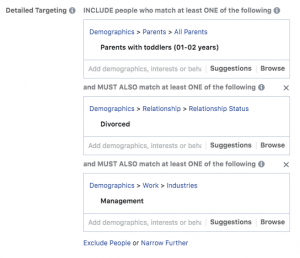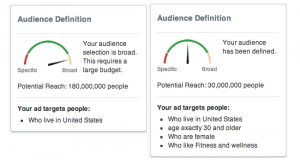SOCIAL MEDIA ADVERTISING – THE IMPORTANCE OF TARGETING
SOCIAL MEDIA ADVERTISING – THE IMPORTANCE OF TARGETING – If you’re reading this, you already know…when advertising on social media, there are many audience targeting options made available to us thanks to “Big Data” a.k.a. marketing’s best friend. While all of this incredible targeting data makes our jobs as marketers, business owners, and creepy stalkers easier and more precise, there can be an ugly side to it as well. Targeting your social media ads too specifically can have a detrimental effect on an otherwise solid social media ad campaign. Here are a few of the basics and what to watch out for!
Besides the obvious profile information, post history, cookies, page likes, etc., Facebook gets very specific user information from third-party data handlers. The reality is that while all users can opt-out of 99% of this data tracking, most are not even aware information is being gathered or they don’t care to change their preferences. Demographic information, such as interest, behavioral, gender, age, etc., gives us the ability to make sure that only our target buyers see our ads rather than all 1.23 billion Facebook users. This allows advertisers to adjust reach and frequency and to measure impressions. Most importantly marketers can now see all of those measurements in relation to who is most likely to buy that product.
How do I target my social media ads?
Facebook allows advertisers to target based on 10 different demographic categories alone. There are also dozens of interest-related categories like “Business and Industry” with even more specific subcategories like “advertising, aviation, banking,” and behavioral categories like “charitable donations” and “purchase behavior.” As you select targeting information, (for example users interested in shopping for clothing) you can layer even more information on top of that (users who are also interested in shopping at high-end retail stores and who are active credit card users)…eventually whittling down over a billion users to a few thousand who are not only interested in your products but who also have the wherewithal to purchase them.
How else can social media ad targeting help me?
Audience targeting can also be beneficial in terms of the context in which ads are created…not just delivered. The knowledge that social media ads can be served specifically to high-end, credit-card-using, clothing shoppers allows your creative department to produce a much more specific product. Similarly, the option of producing 2 unique ads, each targeted at a slightly different persona, is also now an option. For example, instead of creating an ad for a carpet retailer targeting all pet owners, an advertiser can now create one ad targeting dog-lovers and another targeting cat-lovers. The ability to put your content in context like this is quite powerful and the results are easily tracked.
So what’s the secret to social media ad targeting?
If you read this far and were expecting a silver bullet, you’re going to be disappointed. As with anything in marketing and advertising, there is no perfect formula for all companies. The right balance of targeting comes with understanding your specific buyer personas and by testing…lots of testing. The best strategy is to A/B test each ad based on nothing more than targeting…keep your images and copy the same, but play with the interests and behaviors of your potential audience. If you want to try different images or copy, duplicate your targeting in a different ad set so you have a constant. Monitor your ads closely to see which is performing better based on the goals you’ve chosen (clicks, conversions, likes, etc.) and take note. During the next campaign, A/B test again with the most successful targeting from the previous campaign as well as with a different variation. Wash, Rinse, Repeat. The important thing to remember is don’t A/B test one broadly targeted ad against a specific ad…keep the potential reach about the same and measure performance on equal ground.
Other helpful hints:
- Facebook has a handy “Audience Definition” dashboard. Based on your targeting information, it measures your potential reach and even tells you if it thinks your targeting is too specific. The appropriate amount of reach obviously depends on the size and market of your business (an international company would have a fairly large reach compared to a local retailer) but anything number less than 10,000 should garner a good, hard, second look to see if you’re being too specific with your targeting. Facebook won’t even serve to less than 1,000.

- In terms of geography, targeting by location is always recommended for local and regional companies…especially brick and mortar retailers. There is simply no reason for a consumer outside of your sales area to ever see one of your ads…their “like” of your page is just as useless since their potential engagement with your brand will never lead to a conversion into a sale.
- Right Column Ads: Be sure to watch the performance of right column ads. With the increasing popularity (even dependence) on smart phones, fewer and fewer users are logging into Facebook via desktop and these ads are only served on desktops. It can be very eye-opening to turn off right column ads so that ad budget money can be funneled into mobile news feeds where engagement is more likely.





Leave a Reply
Want to join the discussion?Feel free to contribute!